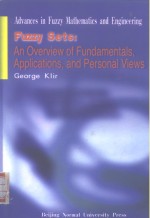

模糊集的理论、应用和新观点PDF电子书下载
- 电子书积分:13 积分如何计算积分?
- 作 者:(美)乔治·克勒
- 出 版 社:北京:北京师范大学出版社
- 出版年份:2000
- ISBN:7303052941
- 页数:358 页
PARTI:FUNDAMENTALS 1
CHAPTER1. CLASSICAL SETS VERSRS FUZZY SETS 1
1.1 Introduction 1
1.2 Crisp Sets: Terminology and Notation 6
1.3 Basic Concepts of Fuzzy Sets 10
1.4 Representations of Fuzzy Sets 18
1.5 Extension Principle 22
CHAPTER 2. OPERATIONS ON FUZZY SETS 28
2.1 Fuzzy Complements 28
2.2 Fuzzy Intersecions and Unions 31
2.3 Averaging Operations 35
2.4 Arithmetic Oerations on Fuzzy Numbers 40
CHAPTER 3. FUZZY RELATIONS 50
3.1 Basic Concepts of Fuzzy Relations 50
3.2 Fuzzy Relations on a Single Set 57
3.3 Fuzzy Relation Equations 65
CHAPTER 4.FUZZY LOGIC 69
4.1 Fuzzy Set Theory and Fuzzy logic 69
4.2 Components of Fuzzy Logic 71
4.3 Approximate Reasoning 79
4.4 Fuzzy Logic and Possibility Theory 81
PART II: APPLICATIONS 87
CHAPTER 5. CONSTRUCTING FUZZY SETS 87
CHAPTER 6. FUZZY SYSTEMS 90
CHAPTER 7. FUZZY CONTROL 96
CHAPTER 8 CLUSTERING, PATTERN RECOGNITION,AND IMAGE PROCESSING 109
CHAPTER 9. DECISION MAKING 112
CHAPTER 10. FUZZY INFORMATION AND KNOWLEDGEBASED SYSTEMS 116
CHAPTER 11. ENGINEERING APPLICATIONS 121
CHAPTER 12. OTHER APPLICATIONS 125
BIBLIOGRAPHICAL COMMENTS TO PARTS I II 129
BIBLIOGRPHICAL INDEX TO PARTS I II 135
BIBLIOGRAPHY TO PARTS I II 139
PART III. PERSONAL VIEWS 173
CHAPTER 13.SIGNIFICANCE OF FUZZY SET THEORY 173
CHAPTER 14.FROM CLASSICAL SETS TO FUZZY SETS:A Grand Paradigm Shift 180
14.1. Introduction 180
14.2. What are Scientific Paradigms and Paradigrn Shifts 181
14.3. Characteristics of the New Uncertainty Paradigm 182
14.4. The Role of Uncertainty in Science and Technology 186
14.5. Stages in the Paradigm Shift 195
14.6. Significant Issues of Future Research 203
References 205
CHAPTER 15. MULTIVALUED LOGICS VERSUS MODAL LOGICS: Alternative Frameworks for Uncertainty Modelling 209
15.1. Attitudes Towards Uncertainty 209
15.2. Uncertainty Theories 211
15.3. Uncertainty and Multivalued Logics 213
15.4. Modal Logics:An Overview 218
15.5. Uncertainty and Modal Logics 228
15.6. Conclusions 248
References 250
CHAPTER 16.MODAL LOGIC INTERPRETATION OF POSSIBILITY THEORY 256
16.1. Introduction 256
16.2. Basics of Possibility Theory 257
16.3. Basics of Modal Logic 258
16.4. Interpretation of Possibility Theory 260
16.5. Completeness 264
16.6. Conclusions 268
References 268
CHAPTER 17.FUZZY-SET INTERPRETATION OF POSSIBILITY THEORY 270
17.1. Introduction 270
17.2. Possibility Theory 271
17.3 Possibility Theory and Dempster-Shafer Theory 274
17.4 Standard Fuzzy-Set Interpretation of Possibility Theory 276
17.5 The Issue of Subnormal Fuzzy Sets 278
17.6 Revised Fuzzy-Set Interpretation of Possibility Theory 281
17.7. Conclusions 286
References 287
CHAPTER 18. CONSTRAINED FUZZY ARITHMETIC 290
18.1. Introduction 290
18.2. Standard Fuzzy Arithmetic 292
18.3. Constrained Fuzzy Arithmetic 294
18.4. Requisite Equality Constraints 298
18.5. Other Requisite Constraints 302
18.6. Applications of Fuzzy Atithmetic 305
18.7. Conclusions 309
References 310
CHAPTER 19. UNCERTAINTY AND PROBABILITY: A Debate 315
19.1. Introduction: Setting the Stage 315
19.2. What is Uncertainty 317
19.3. Mathematical Frameworks for Conceptualizing Uncertainty 319
19.4. Measures of Uncertainty 326
19.5. Limitatios of Probability Theory 334
19.6. Examples 346
19.7. Comclusions 352
References 354
- 《SQL与关系数据库理论》(美)戴特(C.J.Date) 2019
- 《钒产业技术及应用》高峰,彭清静,华骏主编 2019
- 《现代水泥技术发展与应用论文集》天津水泥工业设计研究院有限公司编 2019
- 《联吡啶基钌光敏染料的结构与性能的理论研究》李明霞 2019
- 《情报学 服务国家安全与发展的现代情报理论》赵冰峰著 2018
- 《英汉翻译理论的多维阐释及应用剖析》常瑞娟著 2019
- 《新课标背景下英语教学理论与教学活动研究》应丽君 2018
- 《党员干部理论学习培训教材 理论热点问题党员干部学习辅导》(中国)胡磊 2018
- 《数据库技术与应用 Access 2010 微课版 第2版》刘卫国主编 2020
- 《区块链DAPP开发入门、代码实现、场景应用》李万胜著 2019
- 《SQL与关系数据库理论》(美)戴特(C.J.Date) 2019
- 《魔法销售台词》(美)埃尔默·惠勒著 2019
- 《看漫画学钢琴 技巧 3》高宁译;(日)川崎美雪 2019
- 《优势谈判 15周年经典版》(美)罗杰·道森 2018
- 《社会学与人类生活 社会问题解析 第11版》(美)James M. Henslin(詹姆斯·M. 汉斯林) 2019
- 《海明威书信集:1917-1961 下》(美)海明威(Ernest Hemingway)著;潘小松译 2019
- 《迁徙 默温自选诗集 上》(美)W.S.默温著;伽禾译 2020
- 《上帝的孤独者 下 托马斯·沃尔夫短篇小说集》(美)托马斯·沃尔夫著;刘积源译 2017
- 《巴黎永远没个完》(美)海明威著 2017
- 《剑桥国际英语写作教程 段落写作》(美)吉尔·辛格尔顿(Jill Shingleton)编著 2019
- 《大学计算机实验指导及习题解答》曹成志,宋长龙 2019
- 《指向核心素养 北京十一学校名师教学设计 英语 七年级 上 配人教版》周志英总主编 2019
- 《大学生心理健康与人生发展》王琳责任编辑;(中国)肖宇 2019
- 《大学英语四级考试全真试题 标准模拟 四级》汪开虎主编 2012
- 《大学英语教学的跨文化交际视角研究与创新发展》许丽云,刘枫,尚利明著 2020
- 《北京生态环境保护》《北京环境保护丛书》编委会编著 2018
- 《复旦大学新闻学院教授学术丛书 新闻实务随想录》刘海贵 2019
- 《大学英语综合教程 1》王佃春,骆敏主编 2015
- 《大学物理简明教程 下 第2版》施卫主编 2020
- 《指向核心素养 北京十一学校名师教学设计 英语 九年级 上 配人教版》周志英总主编 2019
